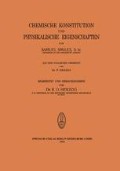Zusammenfassung
Die Fähigkeit, die Ebene des polarisierten Lichtes zu drehen, wurde zuerst von Biot am Quarz beobachtet. Bei näherer Betrachtung der verschiedenen Substanzen, welche diese Eigenschaft zeigen, stellte sich heraus, daß zwei scharf getrennte Gruppen existieren, solche mit vorübergehender und solche mit bleibender optischer Aktivität. Die vorübergehende Aktivität bildet sich 1. bei Stoffen in bestimmten Kristallformen und 2. unter dem Einfluß gewisser äußerer Kraftfelder.
Die Meßmethoden und eingehende physikalische Erläuterungen finden sich in dem klassischen Werke von Landolt, „Das optische Drehungsvermögen.“ 2. Auflage (Braunschweig 1898). Siehe ferner van’t Hoff, Die Lagerung der Atome im Raume, 3. Aufl. (Braunschweig 1908); Werner, Lehrb. d. Stereochemie (Jena 1904); Hantzsch, Grundriß d. Stereochemie, 2. Aufl. (Leipzig 1907); Stewart, Lehrb. d. Stereochemie (Berlin 1908); Bischoff und Walden, Handb. d. Stereochemie (Frankfurt a. M. 1894) u. a.
Access this chapter
Tax calculation will be finalised at checkout
Purchases are for personal use only
Preview
Unable to display preview. Download preview PDF.
Literatur
Zeitschr. f. angew. Chem. 21, 2027 (1908).
Prinzipien der Atomdynamik Bd. II: Die elementare Strahlung (Leipzig 1911), 223.
Landolt, 1. c. S. 210; s. auch Stewart, Journ. Chem. Soc. 91, 1537 (1907).
Vgl. Thomsen, Journ. f. prakt. Chem. [2] 32, 213 (1885); 34, 79 (1886); Schneider, Lieb. Ann. 207, 261 (1881); Schweb el, Ber. d. Dtsch. chem. Ges. 15, 285 (1882); Pr i b r am, das. 22, 6 (1889); Freundler, Ann. Chim. Phys. [7] 4, 256 (1895); Hein, Diss. (Berlin 1896); W in t h é r, Zeitschr. f. phys. Chem. 41, 170 (1902); 45, 355 (1903); 60, 563, 590, 641, 685, 756 (1907); Großmann, das. 73, 148 (1910); 75, 129 (1910); Patterson, Journ. Chem. Soc. 79, 147, 477 (1901); 81, 1097 (1902); 87, 313 (1905); 90, 1839 (1907); 91, 507, 1839 (1907); 93, 355, 935, 1836 (1908); 95, 321, 241 (1909); 101, (1912); Ber. d. Dtsch. chem. Ges. 40, 1243 (1907); 41, (1908). 1128 , 113
Ramsay, Journ. Chem. Soc. 64, 1098 (1893).
Beibl. 9, 635 (1885).
Rec. Tray. Chim. Pays-Bas 1, 18 u. 184 (1882).
Ebenda 1, 144 (1882); für Nikotin s. Schwebe 1, Berl. Ber. 15, 2850 (1876); Carrara, Gazz. Chim. 23 [2], 593 (1893); 24 [2], 94 (1894).
Compt. rend. 110, 744 (1890); s. auch Bose, Phys. Zeitschr. 9, 860 (1908); Zeitschr. f. phys. Chem. 65, 695 (1908).
Vgl. z. B. auch M. Bett!, Cazz. Chim. Ital. 37, I, 62, II, 5 (1907); Hardin und Sikorskij, Journ. de Chim. Phys. 6, 179 (1908); Chardin, Journ. de Chim. Phys. 6, 584 (1908); E. Fischer und E F la t au, Sitzungsber. d. Berl. Akad. 1909, 876; J. W. Walker, Journ. Physical. Chem. 13, 574 (1909).
Vgl. hierzu B a l y, Zeitschr. f. Elektrochem. 17, 211 (1911).
Zeitschr. f. phys. Chem. 20, 569 (1896); vgl. auch Stewart, Proc. Chem. Soc. 23, 8 (1907); Journ. Chem. Soc. 91, 199 (1907).
Vgl. aber P. F. Frankland, Journ. Chem. Soc. 89, 1852, 1859 (1906); 99, 2325 (1912).
Tschugaef f, Ber. 31, 1777 (1898); vgl. auch R. H. Pickard und J. Jates, Journ. Chem. Soc. 89, 1001, 1484 (1906); 95, 1011 (1909); 99, 55 (1911); 101, 620, 1427 (1912).
Journ. Chem. Soc. 93, 1, 700, 1338, 1618 (1908); 95, 289, 331, 1570, 1579 (1908); 97, 223, 1091, 2110 (1910); 99, 218, 224 (1911); Zeitschr. f. phys. Chem. 77, 482 (1911); R u p e, Lieb. Ann. 327, 158 (1903); 369, 311 (1909); 373, 121 (1910).
Journ. Chem. Soc. 83, 514 (1903); vgl. auch das. 93, 242 (1908); 95, 942 (1909).
Compt. rend. 136, 1222 (1903).
Perkin, Pope und Wallach, Journ. Chem. Soc. 95, 1789 (1909); Lieb. Ann. 371, 180 (1910); Journ. Chem. Soc. 99, 1510 (1911).
Pope und Peachey, Journ. Chem. Soc. 77, 1072 (1900).
Pope und Neville, Journ. Chem. Soc. 18, 198 (1902).
Pope und Neville, Journ. Chem. Soc. 18, 198 (1902).
Pope und Peachey, Proc. Chem. Soc. 16, 42 (1900).
Kipping, Journ. Chem. Soc. 91, 209 (1907); 93, 457 (1907); 97, 755 (1910).
Ber. d. Dtsch. chem. Ges. 33, 1003 (1900); Compt. rend. 110, 145 (1890).
Compt. rend. 129, 767 (1899).
Ber. d. Dtsch. chem. Ges. 41, 3966 (1908).
Wedekind, Ber. d. Dtsch. chem. Ges. 40, 1001, 1009, 1646, 4450 (1907); ferner Jones, H i 11, Journ. Chem. Soc. 93, 295 (1908); R. W. Everatt, Journ. Chem. Soc. 93, 1225, 1789 (1908).
Ber. d. Dtsch. chem. Ges. 44, 356 (1911).
Ber. d. Dtsch. chem. Ges. 44, 1887, 2445, 3122, 3272, 3279 (1911); 45, 121, 433 (1912); Arch. des Scienc. phys. et nat. Genève [4] 32, 457 (1911).
Ber. d. Dtsch. chem. Ges. 44, 2023 (1912).
Ann. Chim. Phys. [7] 8, 347 (1896).
Ber. d. Dtsch. chem. Ges. 42, 2244 (1909); Zeitschr. f. phys. Chem. 74, 503 (1910).
Thèses (Paris 1910).
Zeitschr. f. phys. Chem. 76, 469 (1911).
Vgl. auch M. F. M c. Dow e 11, Physical Review 20, 163 (1905); Großmann, Ber. d. Dtsch. chem. Ges. 42, 2646 (1909) u: 1. c.; ferner Zeitschr. d. Ver. Dtsch. Zuckerind. 1912, 19.
Vgl. Walden, Ber. d. Dtsch. chem. Ges. 38, 355 (1905); Hilditsch, Journ. Chem. Soc. 101, 192, 347 (1912).
Author information
Authors and Affiliations
Editor information
Editors and Affiliations
Additional information
Besonderer Hinweis
Dieses Kapitel ist Teil des Digitalisierungsprojekts Springer Book Archives mit Publikationen, die seit den Anfängen des Verlags von 1842 erschienen sind. Der Verlag stellt mit diesem Archiv Quellen für die historische wie auch die disziplingeschichtliche Forschung zur Verfügung, die jeweils im historischen Kontext betrachtet werden müssen. Dieses Kapitel ist aus einem Buch, das in der Zeit vor 1945 erschienen ist und wird daher in seiner zeittypischen politisch-ideologischen Ausrichtung vom Verlag nicht beworben.
Rights and permissions
Copyright information
© 1914 Springer-Verlag Berlin Heidelberg
About this chapter
Cite this chapter
Smiles, S. (1914). Das optische Drehungsvermögen. In: Herzog, R.O. (eds) Chemische Konstitution und Physikalische Eigenschaften. Springer, Berlin, Heidelberg. https://doi.org/10.1007/978-3-642-49808-4_13
Download citation
DOI: https://doi.org/10.1007/978-3-642-49808-4_13
Publisher Name: Springer, Berlin, Heidelberg
Print ISBN: 978-3-642-49519-9
Online ISBN: 978-3-642-49808-4
eBook Packages: Springer Book Archive

